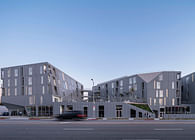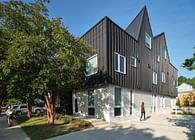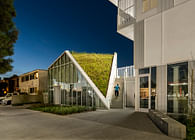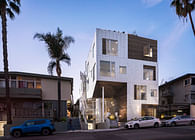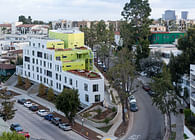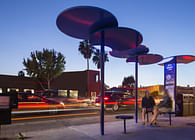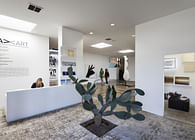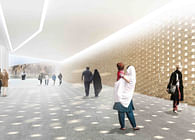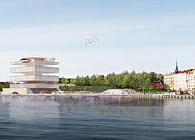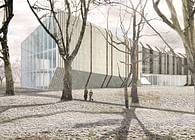
Los Angeles, CA
The Sandi Simon Center for Dance is an expansive new education and performing arts center at Chapman University that redefines a former orange packing house. Landmarked by the National Register of Historic Places, LOHA’s adaptive reuse strategy preserves the exterior identity while opening the interior structure with a calculated cut through the original floor that allows for a reorganization into three levels and forms a new circulation through the space.
The Dance Center houses five studios for dance instruction, a performance studio that provides space for small concerts and master classes, two classrooms, a training room, and faculty offices. It addresses not only the studio and classroom needs of the dance program, but also provides spaces for students to socially engage.
Originally built as a two-story headquarters for the Santiago Orange Growers Association in 1918, the post and beam heavy timber frame building is representative of the industrial vernacular style of its time. Villa Park Orchards Association took over the building in the late 1960s to expand its operations. Chapman University’s purchase of the building signifies a dedication to the preservation of this local historic landmark.
LOHA’s adaptive reuse strategy required precise planning and innovative strategies to transform the former orange packing house, from a one-story warehouse space with an unused, uninhabitable basement, into a multi-level Center for Dance. This process included celebrating unique elements of the existing building, utilizing the original wood flooring as a material for the new design, and incorporating new structural elements.
The design approach of opening the former floor of the 1918 orange packing building allows light to permeate from the historic sawtooth roof—with its north-facing clerestory windows--to all levels of the Dance Center. This innovative strategy preserves the exterior identity of the culturally and historically significant shell, while amplifying the beautiful features of the interior.
Polycarbonate, selected for its reflectivity and translucency, layers walls and openings in ways that allow the architecture to reflect the ideas of movement and the ephemeral nature of performance embodied in the program. Enormous historic trusses were left exposed and rendered at once lofty by the view from the lowest level and tangible from the proximity to them at the mezzanine; and historic, operable clerestory windows have been retrofit with actuators to open and expel heat when triggered by the mechanical system.
The three levels allow for student performances, studios, classrooms, and study spaces within the vibrant circulation and encourages interactions and conversations to spill out of the studios into the atrium between classes, into the courtyard for warm up, yoga, social space, and into the larger campus.
Status: Built
Location: Orange, CA, US
Firm Role: Architect
Additional Credits: Principal-in-Charge: Lorcan O'Herlihy
Project Director: Ghazal Khezri
Project Lead: Joe Tarr, Abel Garcia
Project Team: Morgan Starkey, Kathryn Sonnabend, Ian Dickenson
Project Assist: Kevin Murray, Wentao Guo
Structural: Structural Focus
MEP: Buro Happold
Civil: KPFF
Interior designer: Dotrio, Inc.
Acoustical: Veneklasen Associates
Historic: Historic Resources Group
Signage: IN-FO.CO
Theatre Consultant: Auerbach Pollock Friedlander
Architectural Lighting: Auerbach Glasow and HLB
General contractor: R.D. Olson
Photographer: Eric Staudenmaier

